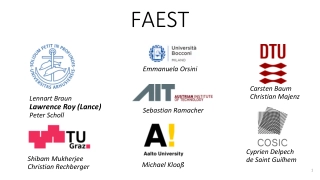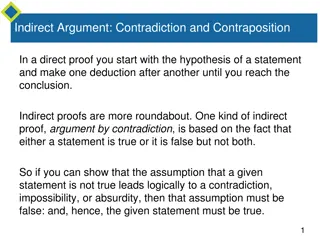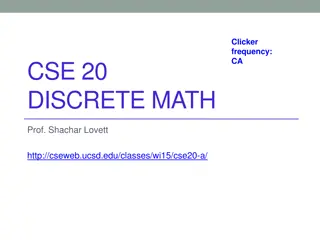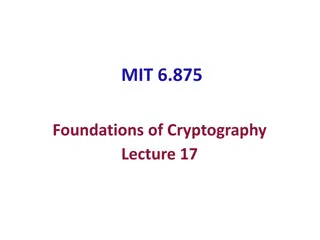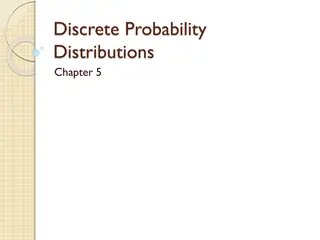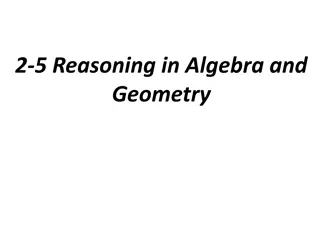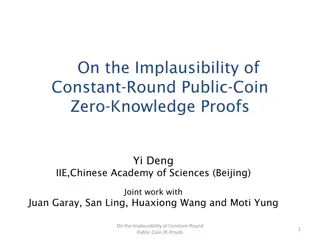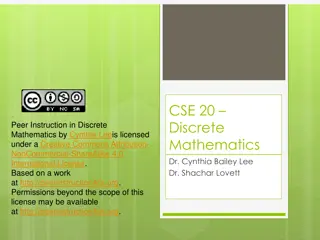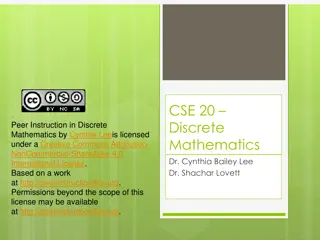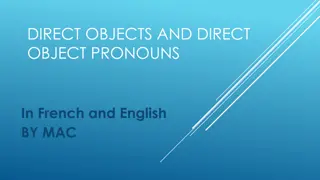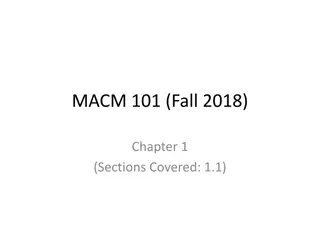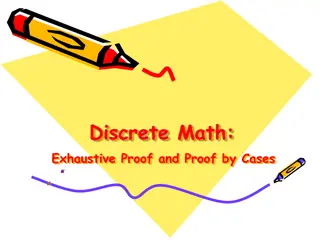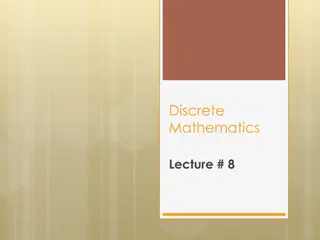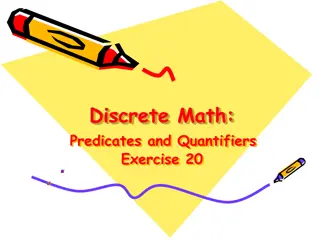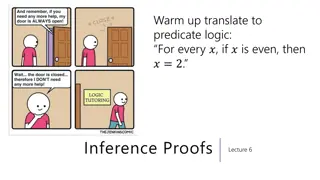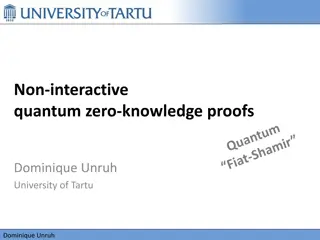Understanding Direct Proofs in Discrete Mathematics
Explore the principles of direct proof in discrete mathematics through a Peer Instruction approach by Dr. Cynthia Bailey Lee and Dr. Shachar Lovett. Learn how to prove theorems of the form "if p, then q" using logical rules, algebra, and math laws. Utilize a clear template for direct proofs, practicing assumptions and conclusions within a structured argumentation framework.
Download Presentation

Please find below an Image/Link to download the presentation.
The content on the website is provided AS IS for your information and personal use only. It may not be sold, licensed, or shared on other websites without obtaining consent from the author. Download presentation by click this link. If you encounter any issues during the download, it is possible that the publisher has removed the file from their server.
E N D
Presentation Transcript
Creative Commons License CSE 20 Discrete Mathematics Dr. Cynthia Bailey Lee Dr. Shachar Lovett Peer Instruction in Discrete Mathematics by Cynthia Leeis licensed under a Creative Commons Attribution- NonCommercial-ShareAlike 4.0 International License. Based on a work at http://peerinstruction4cs.org. Permissions beyond the scope of this license may be available at http://peerinstruction4cs.org.
2 Today s Topics: 1. Proving a theorem of the form if-then, Part I: Direct Proof Template 2. Proving a theorem of the form if-then, Part II: Identifying implicit if-then 3. Generalization from a generic particular
3 1. Proving a theorem of the form if-then, Part I
4 Truth table for implication p T T F F q T F T F p q T F T T Note there is only one F This is when p the if part is true, and the then part is false To prove an implication is true, we must show this F row cannot happen
5 Proving an implication p q Procedure: 1. Assume p is true (take it as given ) 2. Show that q logically follows, in other words, derive q just from: The assumption that p is true Definitions Axioms Includes basic algebra and math laws Applying logical rules/valid argument forms
6 Direct Proof Template Thm. [write the theorem to be proved if p, then q. ] Proof: Given: Assume [p]. WTS: [q]. This is clearly identifying to the reader what you will be trying to reach in the main body of the proof. Main body of the proof: Using p, try to end up with q. end with [q], which is what was to be shown." This clearly identifies for the reader that you reached what you said you were going to reach in the WTS section.] Conclusion: Therefore, [restate theorem]. QED.
7 Test yourself: Direct Proof Template For a theorem of the form: If p, then q. Given is where you make an assumption that p is true. What does this assumption really mean? A. p could be true or false, but we are just saying it is true for the sake of argument. B. p is always true. C. p is always false, but we are just saying it is true in the proof. D. p is guaranteed to be true within the scope of the proof. E. Other/none/more
8 Test yourself: Direct Proof Template Want to Show (WTS) is your goal for the main body of the proof. If your theorem is If it is raining, then I will need an umbrella, what is your WTS? A. If it is raining, then I will need an umbrella. B. Assume it is raining. C. I will need an umbrella. D. QED E. Other/none/more
9 Direct Proof Template: Mathematical Driving Directions
10 Direct Proof Template: Mathematical Driving Directions
11 2. Proving a theorem of the form if-then, Part II
12 Test yourself: Direct Proof Template Thm. The sum of any two odd numbers is even. What are your Given and WTS? Given: Assume the sum of two odd numbers is even. WTS: This follows from axioms of algebra. Given: Assume x and y are odd numbers. WTS: x + y is even. Given: Assume 3 and 5* are odd. WTS: sum of 3 and 5 is even. You can t use Direct Proof Template for this theorem because it is not of the form If then . Other/none/more A. B. C. D. E. * You could pick something else but we just happened to pick 3 and 5
13 Proof Keywords: Introducing/declaring variables in the Given section As you know, the Given section announces that you are assuming the p part of the p IMPLIES q theorem is true Given: Assume x and y are odd numbers. But sometimes the word assume is replaced by other options meaning the same thing Given: Let x and y be odd numbers. Given: Suppose x and y are odd numbers.
14 Example Thm.: The sum of any two odd numbers is even. Proof: Given: Let x and y be odd numbers. WTS: z = x + y is even. Conclusion: So z is even, which is what was to be shown, therefore the sum of any two odd numbers is even.
15 What we have to work with Given: x and y are odd Definition: odd means an integer k such that [odd number] = 2k + 1. Definition: even means an integer k such that [even number] = 2k. Axiom: sum of two integers is an integer. algebra logic
16 Example Thm.: The sum of any two odd numbers is even. Proof: Given: Let x and y be odd numbers. WTS: z = x + y is even. Try it yourself first Conclusion: So z is even, which is what was to be shown, therefore the sum of any two odd numbers is even.
17 Example Thm.: The sum of any two odd numbers is even. Proof: Given: Let x and y be odd numbers. WTS: z = x + y is even. Let x and y be odd numbers. By definition, x=2a+1 and y=2b+1 where a,b are integers. So, z=x+y=(2a+1)+(2b+1)=2a+2b+2=2(a+b+1). That is, z=2c where c=a+b+1 is an integer. Hence, c is even Conclusion: So z is even, which is what was to be shown, therefore the sum of any two odd numbers is even.


